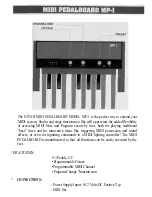
Style Functions
48
PSR-K1 Owner’s Manual
Playing accompaniment chords
There are two basic ways of playing chords for the accompaniment: Single Finger and
Fingered.
This instrument uses a sophisticated function called Multi Fingering, which automatically
recognizes the chord played, no matter which way of fingering you use.
• Single Finger.........................................Simple chord indications
• Fingered ................................................Conventionally played chords
The key range left of the Split Point (default setting: 54 or F
#
2) is referred to as the auto
accompaniment section of the keyboard. When using accompaniment, play the chords in
this range.
■
Single Finger
This method lets you easily play major, minor, seventh and minor seventh chords in
the auto accompaniment section of the keyboard by using three fingers or less.
■
Fingered
This method lets you play chords normally within the auto accompaniment section of
the keyboard, and the instrument plays the proper accompaniment.
• The explanations here are applica-
ble only when the [STYLE] button
is turned on.
NOTE
Split Point (default setting: 54 or F
#
2)
• The Split Point can be changed.
(See page 42.)
NOTE
• The illustration below shows the
root names of the chords and their
corresponding keys.
NOTE
Split Point
(54 or F
#
2)
accompaniment section
of the keyboard
●
How to play Single Finger chords
• To play a major chord
Press the root note of the
chord.
• To play a minor chord
Press the root note together
with the nearest black key to
the left of it.
• To play a seventh chord
Press the root note together
with the nearest white key to
the left of it.
• To play a minor seventh
chord
Press the root note together
with the nearest white and
black keys to the left of it
(three keys altogether).
C
C
m
C
7
C
m7
●
How to play Fingered chords
[Example for “C” chords]
* Notes enclosed in parentheses are optional; the chords will be recognized without them.
( )
( )
( )
( )
( )
( )
( )
( )
( )
( )
( )
( )
( )
( )
( )
( )
( )
( )
( )
C
mM7
C
M7
C
6
C
sus4
C
aug
C
M7aug
C
7aug
C
7sus4
C
sus2
C
7
C
m
C
dim
C
dim7
C
7
C
mM7
(
9
)
C
M7
(
9
)
C
m7
(
9
)
C
7
(
b
9
)
C
7
(
b
13
)
C
m7
(
11
)
C
M7
(
#
11
)
C
(
b
5
)
C
(
9
)
(
9
)
C
6
(
9
)
C
m
(
9
)
C
7
(
#
11
)
C
7
(
#
9
)
C
7
(
13
)
C
7
C
m6
C
m7
C
(
b
5
)
C
M7
(
b
5
)
C
m7
(
b
5
)
C
mM7
(
b
5
)
















































